- Prelude
- Hard Talk
- New Media
- Rolex : An Overview
- The age of Revivals: Neoclassical Furniture
- Democratization of the Medium No-Budget film: the Indian Context (!)
- Old Sound New Sound
- Decan Odyssey
- North East Opsis
- Russian cool breeze in hot Paris
- Around Kolkata
- Musings from Chennai
- In and around Santiniketan
- In between – from Vadodra
- A Tryst with Art in Madhya Pradesh
- Through the Looking Glass
- The Foreign Connection
- Market Insight
- Market Report
- Artist Index and Statistics
- Auction Reports
- The month that was
- Delhi Dias
- Art Bengaluru
- Mumbai Art Sighting
- Creative Impulse
- Subodh Gupta
- Pooja Iranna
- Preview
- In the News
ART news & views
A Tryst with Art in Madhya Pradesh
Volume: 2 Issue No: 9 Month: 10 Year: 2010
Art dialogic of the next generation artists
When we talk about the next generation artists, we try to score their art on the measures of experimentation, innovation and freshness, also insist upon finding something that can be isolated in order to be enjoyed.  But if without this prejudice we look at any work of art, it will convey much more that calls forth not the cognitive but the emotional response of the viewers. Materials, mediums, methods or techniques are merely the tools in the realization of individual emotions to the impulses of both the inside and outside world of an artist. In the same way an artist can not be isolated from his social, cultural and personal environment so, his art should always be seen in these perspectives. As in Indian art we find a great diversity only due to diversity in its social, cultural and geographical environment that go on to shape the spiritual, physical, mental and visual sensibilities of an artist. It is this individual sensibility and strength that make his expressions unique in creating a powerful impact--both emotionally and visually. In the light of this fact, I too am attempting to approach and appreciate the next generation artists of Madhya Pradesh.
But if without this prejudice we look at any work of art, it will convey much more that calls forth not the cognitive but the emotional response of the viewers. Materials, mediums, methods or techniques are merely the tools in the realization of individual emotions to the impulses of both the inside and outside world of an artist. In the same way an artist can not be isolated from his social, cultural and personal environment so, his art should always be seen in these perspectives. As in Indian art we find a great diversity only due to diversity in its social, cultural and geographical environment that go on to shape the spiritual, physical, mental and visual sensibilities of an artist. It is this individual sensibility and strength that make his expressions unique in creating a powerful impact--both emotionally and visually. In the light of this fact, I too am attempting to approach and appreciate the next generation artists of Madhya Pradesh.
In Madhya Pradesh, after the establishment of Bharat Bhawan, a large number of young artists got attracted to the magnet of this live centre of art.  Many couldn't resist the lure of both--the facilities available in this multi-art complex and the charm of the beautiful city of Bhopal (who still continue to live here). Away from the hustle and bustle, in Bhopal they found a place ideal for carving their artistic talent. Gradually, Bharat Bhawan became a centre pulsating with creative activities. Its facilities for print-making and ceramics are still attracting students and artists from not only Madhya Pradesh but from all over the country. Mrs. Indra Gandhi had rightly remarked that with the opening of Bharat Bhawan, the centre of art has been shifted from Delhi to Bhopal. Now today, Bhopal has virtually become a capital of art, encompassing the whole India in its bower.
Many couldn't resist the lure of both--the facilities available in this multi-art complex and the charm of the beautiful city of Bhopal (who still continue to live here). Away from the hustle and bustle, in Bhopal they found a place ideal for carving their artistic talent. Gradually, Bharat Bhawan became a centre pulsating with creative activities. Its facilities for print-making and ceramics are still attracting students and artists from not only Madhya Pradesh but from all over the country. Mrs. Indra Gandhi had rightly remarked that with the opening of Bharat Bhawan, the centre of art has been shifted from Delhi to Bhopal. Now today, Bhopal has virtually become a capital of art, encompassing the whole India in its bower.
In Madhya Pradesh a new crop of artists is beginning to make their own mark. They are using a wide range of mediums--dry pastel, acrylic, oil, water colour etc.--that suit to their nature/temperament. Their choice of medium might be conscious, but their expressions are spontaneous. 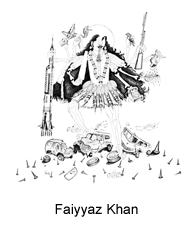 Their expressions might be categorized as conceptual/figurative, abstraction, abstract; they might be using different techniques of printing and painting; they might have adopted different materials, their treatment of it is virtually unique and individual. Some narrate stories or incidents, others stir our delight and wonder and awake in us, a sense of beauty, mystery, hope and fear. Some create an idealized picture of the world; others are establishing the relation of the self with the dynamic cosmos. Some are going out of themselves to deal with the outside world, while others listen to the dictates of their inner world. Some are infallible in their expressions of indigenous elements, while others are merging indigenous and modern expressions.
Their expressions might be categorized as conceptual/figurative, abstraction, abstract; they might be using different techniques of printing and painting; they might have adopted different materials, their treatment of it is virtually unique and individual. Some narrate stories or incidents, others stir our delight and wonder and awake in us, a sense of beauty, mystery, hope and fear. Some create an idealized picture of the world; others are establishing the relation of the self with the dynamic cosmos. Some are going out of themselves to deal with the outside world, while others listen to the dictates of their inner world. Some are infallible in their expressions of indigenous elements, while others are merging indigenous and modern expressions.
In Harish Ojha's Paintings, indigenous nuances are quite apparent. Being brought up in rural India, he still finds himself attached to those indigenous wooden toys of bright colours. (mainly of red and green) These invaluable treasures of his childhood are the main motifs of his paintings. Though abstract, his images can remind us of the wooden cart, (Lakdi Ki Kathi) the pull cart and the rattles.  (now can be seen only in local village fares) By adding these indigenous elements in his otherwise contemporary idiom, Harish revives folk imagery to merge it with his own individual style. While Harish captures the Indian folk images, Anil Ijeri has a fascination for the Egyptian mythology, giving Hellenic quality to his collographs. Though there is no palpable design and images are chosen with unconscious text, there is a rare sculpture grace. Each is chosen with exquisite fastidiousness but without destroying their spontaneity and rhythm. Perhaps the elements are the usual objects of Greek mythology --mummies, pyramid, calligraphy, ancient script, acquarium urn etc. but the harmony that he maintains in these elements is quite unusual.
(now can be seen only in local village fares) By adding these indigenous elements in his otherwise contemporary idiom, Harish revives folk imagery to merge it with his own individual style. While Harish captures the Indian folk images, Anil Ijeri has a fascination for the Egyptian mythology, giving Hellenic quality to his collographs. Though there is no palpable design and images are chosen with unconscious text, there is a rare sculpture grace. Each is chosen with exquisite fastidiousness but without destroying their spontaneity and rhythm. Perhaps the elements are the usual objects of Greek mythology --mummies, pyramid, calligraphy, ancient script, acquarium urn etc. but the harmony that he maintains in these elements is quite unusual.
Satyadhir creates his own world, a world of fantasy where one can reach only by travelling the alleyways of the real world. He believes, every one has a desire to escape the pressures of life to get some time to fulfill his aspirations but he can realize this only in dreams, so he creates his own fairy land to find some release from the sordid and ugly realities of life. Satyadhir picks the ambitions and concerns of a common man of modern India as a theme for his paintings. His protagonists are mainly rickshawalas and the love seeking couples. Their arms and legs are shown to be excessively flexible and extended, for imagination has no bounds. The realization that everything is possible only adds to one's enthusiasm. His paintings have pictorial qualities, they are like renditions of poetry or drama. He always chooses the upper space to create his fantasy world, for dreams are born in air. 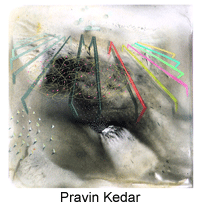 His works are abound with conceptual and visual richness.
His works are abound with conceptual and visual richness.
Faiyyaz is carving out his own niche through his ink drawings. His drawings have a perfect fusion of modern and traditional aspects. He takes images from both the real and the mythological world and behind it is the shadow of ruin, both physical and spiritual. Sometimes images seem grotesque and distorted but an informed eye can notice thematic ensembles in them. They are the modern mutations of deity where incense stick and flower wreath have turned into rifles and grenades. Through these images he shows his concern for the loss of religious sensibilities.
Away from all the concerns and worries of her outer world, Gauri creates a world of animation where she aims at giving pleasure. Seemingly strange, her mammoth figures have the quality of stimulating our impulse of laughter and amusement. Figures overlap to emerge distinctly on the plane acrylic background. Dots and lines are not used for mere embellishments. If Gauri invokes the child in us, Braj Mohan awakes the sensuous being. 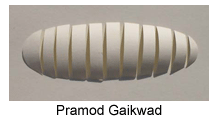 He attempts an idealized picture of the Indian culture. Images of past revisit in his works. We find an intimate tone that seems to hover over his canvas. "Braj Mohan reconciles the dual attractions of art and reality with skill. He can not therefore be accused of replacing the poetry of invention with the prose of fact." (Keshav Malik) In this way his work is a bridge between worlds. He enjoys life on his canvas in all its shades. His paintings have a poetic quality, capable of creating a unique music with the symphony of colours and contours.
He attempts an idealized picture of the Indian culture. Images of past revisit in his works. We find an intimate tone that seems to hover over his canvas. "Braj Mohan reconciles the dual attractions of art and reality with skill. He can not therefore be accused of replacing the poetry of invention with the prose of fact." (Keshav Malik) In this way his work is a bridge between worlds. He enjoys life on his canvas in all its shades. His paintings have a poetic quality, capable of creating a unique music with the symphony of colours and contours.
Shailendra's sculptures speak of natural tenderness connected with life. His works have an amazing quality of spontaneity and control. His skillful and sensitive handling of soft and tactile qualities of clay is quite remarkable. He doesn't believe in disturbing the natural and pure textures and colours by applying artificial glaze. Rural imagery and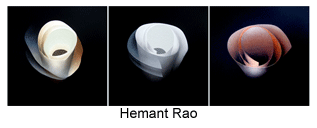 experiences are quite evident in his expressions, though he alludes to represent things as they are. He recollects how as a child he would always watch his mother making huge-sized granaries from clay. It was quite a delight for him to watch her giving attractive shapes. Whenever he would cry, she would give him the same clay to play with. Now this play of childhood has become a passion for him to satiate the creative urge in him.
experiences are quite evident in his expressions, though he alludes to represent things as they are. He recollects how as a child he would always watch his mother making huge-sized granaries from clay. It was quite a delight for him to watch her giving attractive shapes. Whenever he would cry, she would give him the same clay to play with. Now this play of childhood has become a passion for him to satiate the creative urge in him.
When Shailendra is discovering the very earthiness of the earth, Pravin Kedar is propelling on his journey to the cosmic space. His quest is to become a part of that endless spatial energy that illuminates the entire mysterious astronomical activity; that tremendous divine energy that unites all into one. His lines, dots, spirals, geometry on the black surface capture the vividness and power of the heavenly world of stars, galaxies, constellations. If Pravin sees the presence of the divine energy in the celestial world, Pramod finds it every where, in all forms, in all hues, it is all pervading in nature. Pramod is an ardent admirer of the vast beauty of nature that gives him eternal rejoice. Sometimes his love of nature makes him wander off into the unknown. He has no preconditions about palettes, forms, compositions, even materials. He feels quite at ease while experimenting 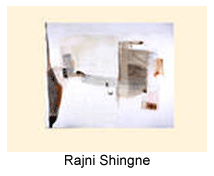 with varying mediums--Aluminium plates, oil colours on canvas, foren plywood. Every time he maintains his basic qualities of seamless flow and gradation of colours. He has no place for imagination, as it can be an illusion. Only realization and expression are the core virtues of his art.
with varying mediums--Aluminium plates, oil colours on canvas, foren plywood. Every time he maintains his basic qualities of seamless flow and gradation of colours. He has no place for imagination, as it can be an illusion. Only realization and expression are the core virtues of his art.
Moving to abstract from figurative/conceptual--abstraction, we find another group of artists that doesn't believe in any preconception or deliberate designs. Once completely absorbed in their ebb and flow, our eyes will learn to follow their music. Anand, Hemant, Rahul, Pradeep, Simran and Rajni belong to this genre of art. Rajni's aestheticism is not a structured one and nor it's utilitarian in its own. As for her lines and colours, the eminent artist Yusuf believes to have "their own agnostic existence, independent of any conscious purpose. They seem to entrap an entirety in their own. Somewhere we could figure out that their continual entropy is a sort of play into eternity."
In Rahul's works we find a complete sense of liberation and defiance from any assorted scheme. He is unconcerned of any particular style, breaking himself free from any preconditions or boundaries. Pradeep's interest is in connecting the complex relationships between the natural world and the personal experiences. His lines and colours find their evolution from that single source which when splits, gives multitude lines and colours, creating a prismatic effect. Anand Prakash's oeuvre chiefly rests on his effective conglomeration of colours, forms and textures. On light flat background, if some forms merge to create transparency, others are emerging to enhance its visual appeal. It strikes quite a harmonious balance between his space and forms with their tonal moderations.
Hemant's inspiration stems from the natural environment of his country living. He always felt an attraction in the soft, natural, delicate tones of butterflies, flowers, feathers. His great dexterity over the application of dry pastel helps him lay bare this softness in his unpremeditated forms. Simran had always wanted to create and usually engineer something unique into existence. Steel has always intrigued her for its quality of malleability and strength. This made her use this metal as a base in her art practice. She uses tiny steel balls, electric wire, sometimes thread to emboss onto paper, where the material retains its inherent properties. It works its way out of the paper at some places, breaking away from what it was meant to represent, giving the viewer a peek into what might be underneath. She maintains an interesting contrast between fragility of paper and the strength of metal. When she creates forms out of nothingness, she always wishes to have explored every possibility of each structure, shape and form by the end of her journey on the planet earth.